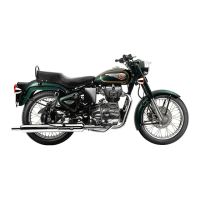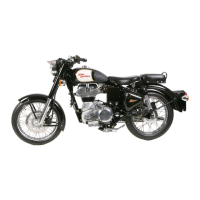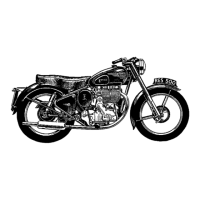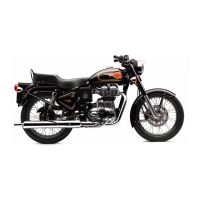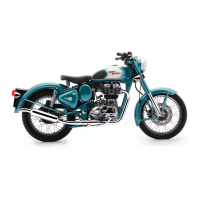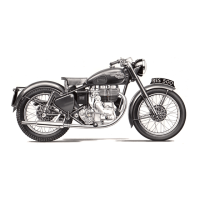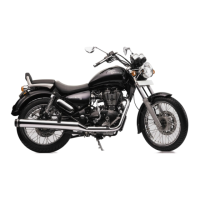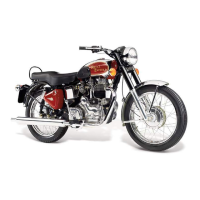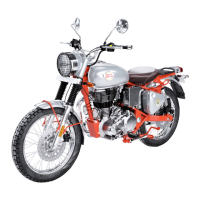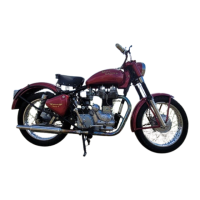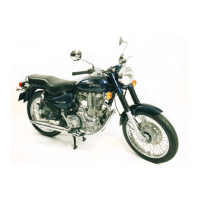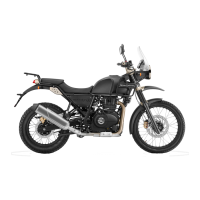Do you have a question about the Royal Enfield Rumbler 500 2017 and is the answer not in the manual?
| Engine Type | Single Cylinder, 4 Stroke, Air Cooled |
|---|---|
| Displacement | 499 cc |
| Bore x Stroke | 84 mm x 90 mm |
| Compression Ratio | 8.5:1 |
| Maximum Power | 27.2 bhp @ 5250 rpm |
| Maximum Torque | 41.3 Nm @ 4000 rpm |
| Clutch | Wet, Multi-plate |
| Chassis Type | Single Downtube, Using Engine as Stressed Member |
| Front Tyre | 90/90 - 19 |
| Rear Tyre | 120/80 - 18 |
| Fuel Tank Capacity | 20 liters |
| Seat Height | 800 mm |
| Gearbox | 5 Speed Constant Mesh |
| Front Suspension | Telescopic |
| Rear Suspension | Twin Shock Absorbers |
| Front Brake | Disc Brake |
| Rear Brake | Disc, 240mm |
| Ignition System | Electronic Ignition (T.C.I) |
Details of the motorcycle's engine type, bore, stroke, and capacity.
Information on ignition system, clutch, gearbox, and final drive ratios.
Specifications for frame, suspension, brakes, tyre sizes, and electricals.
Physical measurements and weight ratings of the motorcycle.
Specifies grade and quantity for engine oil and oil changes.
Details on front fork oil and brake fluid types and capacities.
Identifies the location of the motorcycle's frame identification number.
Identifies the location of the motorcycle's engine identification number.
Identifies controls and components visible from the top view.
Identifies components on the right side of the motorcycle.
Identifies components on the left side of the motorcycle.
Instructions for locking the steering and operating the ignition switch.
Procedures for using the engine stop switch and electric start button.
Operation of horn, headlight, turn signals, and choke lever.
Explains the digital instrument cluster and its display functions.
Guidelines for appropriate riding apparel and safety gear.
Advice on maintaining a stable and safe riding posture.
Best practices for using front and rear brakes effectively and safely.
Explains the meaning and behavior of the MIL indicator.
Describes the safety feature of the rollover sensor and its operation.
Step-by-step guide for starting the engine using the kick starter.
Step-by-step guide for starting the engine using the electric starter.
Procedure for parking the motorcycle using the center stand.
Procedure for parking the motorcycle using the side stand.
Schedule for engine oil and filter checks and replacements.
Schedule for spark plug and air filter maintenance.
Maintenance schedule for brake fluid, fuel pump, and hoses.
Maintenance for spokes, swing arm, tyre wear, and drive chain.
Tips for lubricating cables, pivots, and adjusting controls.
Procedures for engine oil change, spark plug, and brake fluid maintenance.
Inspection, removal, replacement of tyres, wheels, brake pads, and pedal adjustment.
Guidance on drive chain maintenance, tension, and air filter element care.
Steps for battery maintenance, removal, and replacement of bulbs/fuses.
Instructions for adjusting rear shock absorbers and fitting chain lock.
Essential checks before starting a long journey.
Checks after 1500 kms and list of items to carry on trips.
Safety measures and preparation steps before washing the motorcycle.
Procedures to follow after washing, including drying and lubrication.
Basic guidelines for starting motorcycles with electric start systems.
Causes and remedies for engine start, misfiring, pickup, smoke, and fuel consumption.
Solutions for spongy brakes, motorcycle wobbles, and tyre issues.
Diagnosis for electrical faults, horn, trafficators, EFI, and MIL indicator problems.
Troubleshooting for the instrument cluster and LCD display panel.
